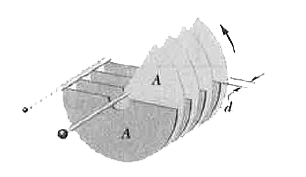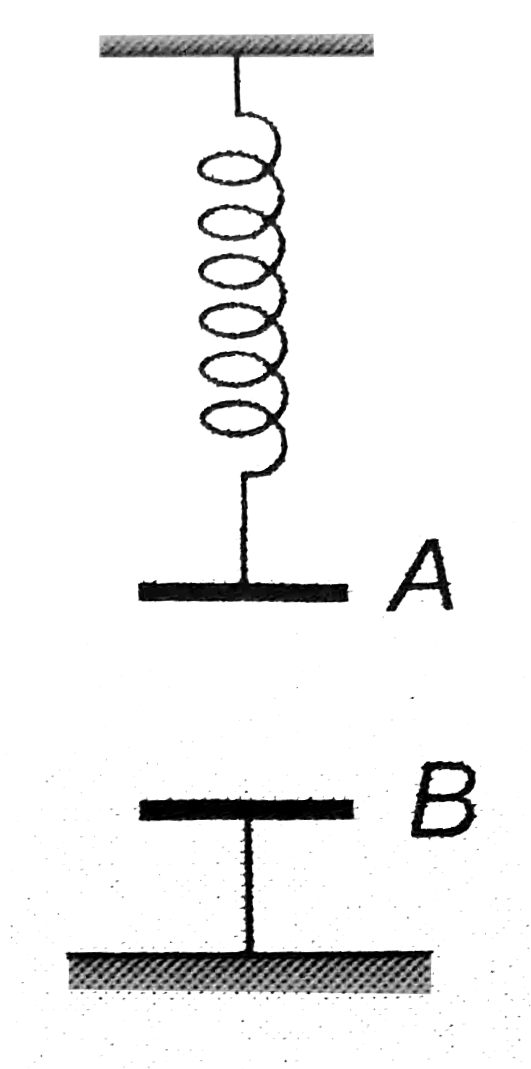A variable air capacitor used in radio tuning circuit is made of N semi-cireuler plates each of radius Rand positioned a distance d from its neighboring plates. A second set of similar plates is enmeshed with its plates half-way between those of first set. Second set of plates can rotate as a complete

Nε0(π−θ)R2d
(N−1)ε0(π−θ)R2d
(N−2)ε0(π−θ)R2d
(2N−2)ε0(π−θ)R2d
The correct Answer is:D
Related Playlists
- BOOK - AAKASH SERIESCHAPTER - CAPACITORS EXERCISE - PRACTICE SHEET (ADVANCED) (Linked Comprehension Type Questions Passage)4videos
CAPACITORS
- BOOK - AAKASH SERIESCHAPTER - CAPACITORS EXERCISE - PRACTICE SHEET (ADVANCED) (Integer Type Questions)2videos
CAPACITORS
- BOOK - AAKASH SERIESCHAPTER - CAPACITORS EXERCISE - ADDITIONAL PRACTICE EXERCISE (LEVEL - II LECTURE SHEET (ADVANCED))(Integer Type Questions )3videos
CAPACITORS
- BOOK - AAKASH SERIESCHAPTER - ATOMSEXERCISE - PRACTICE EXERCISE21videos
ATOMS
- BOOK - AAKASH SERIESCHAPTER - COMMUNICATION SYSTEM EXERCISE - LECTURE SHEET (LEVEL - I) (MAIN) (EXERCISE - IV) (Straight Objective & More than one Correct Answer Type Questions)20videos
COMMUNICATION SYSTEM
Knowledge Check
- Question 1 - Select One
A radio capacitor of variable capacitance is made of n parallel plates each of area A and separated from each other by a distanced. The alternate plates are connected together. The capacitance of the combination is.
AnA∈odB(n−1)A∈odC(2n−1)A∈odD(n−2)A∈od - Question 1 - Select One
Read the following text and answer the following questions on the basis of the same:
Tuning a radio set: In essence the simplest tuned radio frequency receiver is a simple crystal set. Desired frequency is tuned by a tuned coil/ capacitor combination, and then the signal is presented to a simple crystal or diode detector where the amplitude modulated signal, is demodulated. This is then passed straight to the headphones or speaker. In radio set there is an LC oscillator comprising of a variable capacitor (or sometimes a variable coupling coil), with a knob on the front panel to tune the receiver.
Capacitor used in old radio sets is gang capacitor. It consists of two sets of parallel circular plates one of which can rotate manually by means of a knob. The rotation causes overlapping areas of plates to change, thus changing its capacitance. Air gap between plates acts as dielectric.
The capacitor has to be tuned in tandem corresponding to the frequency of a station so that the LC combination of the radio set resonates at the frequency of the desired station.

When capacitive reactance (XC) is equal to the inductive reactance (XL), then the resonance occurs 1 and the resonant frequency is given by ω0=1√LC current amplitude becomes maximum at the resonant frequency. It is important to note that resonance phenomenon is exhibited by a circuit only if both L and C are present in the circuit. Only then do the voltages across L and C cancel each other (both being out of phase) and the Current amplitude is open, VmR, the total source voltage appearing across R.
This means that we cannot have resonance in a RL or RC circuit.
Capacitor used in radio set for tuning is a:Aparallel plate capacitorBspherical capacitorCpaper capacitorDelectrolytic capacitor - Question 1 - Select One
Read the following text and answer the following questions on the basis of the same:
Tuning a radio set: In essence the simplest tuned radio frequency receiver is a simple crystal set. Desired frequency is tuned by a tuned coil/ capacitor combination, and then the signal is presented to a simple crystal or diode detector where the amplitude modulated signal, is demodulated. This is then passed straight to the headphones or speaker. In radio set there is an LC oscillator comprising of a variable capacitor (or sometimes a variable coupling coil), with a knob on the front panel to tune the receiver.
Capacitor used in old radio sets is gang capacitor. It consists of two sets of parallel circular plates one of which can rotate manually by means of a knob. The rotation causes overlapping areas of plates to change, thus changing its capacitance. Air gap between plates acts as dielectric.
The capacitor has to be tuned in tandem corresponding to the frequency of a station so that the LC combination of the radio set resonates at the frequency of the desired station.

When capacitive reactance (XC) is equal to the inductive reactance (XL), then the resonance occurs 1 and the resonant frequency is given by ω0=1√LC current amplitude becomes maximum at the resonant frequency. It is important to note that resonance phenomenon is exhibited by a circuit only if both L and C are present in the circuit. Only then do the voltages across L and C cancel each other (both being out of phase) and the Current amplitude is open, VmR, the total source voltage appearing across R.
This means that we cannot have resonance in a RL or RC circuit.
Name the phenomenon involved in tuning a radio set to a particular radio station.AStabilizationBRectificationCResonanceDReflection - Question 1 - Select One
Read the following text and answer the following questions on the basis of the same:
Tuning a radio set: In essence the simplest tuned radio frequency receiver is a simple crystal set. Desired frequency is tuned by a tuned coil/ capacitor combination, and then the signal is presented to a simple crystal or diode detector where the amplitude modulated signal, is demodulated. This is then passed straight to the headphones or speaker. In radio set there is an LC oscillator comprising of a variable capacitor (or sometimes a variable coupling coil), with a knob on the front panel to tune the receiver.
Capacitor used in old radio sets is gang capacitor. It consists of two sets of parallel circular plates one of which can rotate manually by means of a knob. The rotation causes overlapping areas of plates to change, thus changing its capacitance. Air gap between plates acts as dielectric.
The capacitor has to be tuned in tandem corresponding to the frequency of a station so that the LC combination of the radio set resonates at the frequency of the desired station.

When capacitive reactance (XC) is equal to the inductive reactance (XL), then the resonance occurs 1 and the resonant frequency is given by ω0=1√LC current amplitude becomes maximum at the resonant frequency. It is important to note that resonance phenomenon is exhibited by a circuit only if both L and C are present in the circuit. Only then do the voltages across L and C cancel each other (both being out of phase) and the Current amplitude is open, VmR, the total source voltage appearing across R.
This means that we cannot have resonance in a RL or RC circuit.
Resonance frequency is equal to:A1LCB1/√LCC√LCD√CL - Question 1 - Select One
Read the following text and answer the following questions on the basis of the same:
Tuning a radio set: In essence the simplest tuned radio frequency receiver is a simple crystal set. Desired frequency is tuned by a tuned coil/ capacitor combination, and then the signal is presented to a simple crystal or diode detector where the amplitude modulated signal, is demodulated. This is then passed straight to the headphones or speaker. In radio set there is an LC oscillator comprising of a variable capacitor (or sometimes a variable coupling coil), with a knob on the front panel to tune the receiver.
Capacitor used in old radio sets is gang capacitor. It consists of two sets of parallel circular plates one of which can rotate manually by means of a knob. The rotation causes overlapping areas of plates to change, thus changing its capacitance. Air gap between plates acts as dielectric.
The capacitor has to be tuned in tandem corresponding to the frequency of a station so that the LC combination of the radio set resonates at the frequency of the desired station.

When capacitive reactance (XC) is equal to the inductive reactance (XL), then the resonance occurs 1 and the resonant frequency is given by ω0=1√LC current amplitude becomes maximum at the resonant frequency. It is important to note that resonance phenomenon is exhibited by a circuit only if both L and C are present in the circuit. Only then do the voltages across L and C cancel each other (both being out of phase) and the Current amplitude is open, VmR, the total source voltage appearing across R.
This means that we cannot have resonance in a RL or RC circuit.
Resonance occurs only when:AXC=RBXL=RCXL=XCDXC>XL
Similar Questions
A variable capacitor has n plates and the distance between two successive plates is d. determine its capacitance.
View SolutionTwo parallel air capacitors have their plate areas 100cm2 and 500cm2, respectively. If they have the same charge and potential, and the distance between the plates of the first capacitor is 0.5 mm, what is the distance between the plates of the second capacitor?
View SolutionTwo parallel plate air capacitors have their plate areas 100and500cm2 respectively. If they have the same charge and potential and the distance between the plates of the first capacitor of 0.5 mm, what is the distance between the plates of second capacitor ?
View SolutionFigure 25-35 shows a variable "air gap" capacitor for manual training Alternate plates are connected together, one group of plates is fixed in position, and the other group is capable is rotation. Consider a capacitor of n=8 plates of alternating polarity, each plate having area A=1.50cm2 and separated from adjacent plates by distance d=3.40mm. What is the maximum capacitance of the device?
 View Solution
View SolutionA paallel plate capacitor with air as a dielectric is arranged horizontally. The lower plate is fixed and the other connected with a perpendicular spring. The area of each plate is A and mass of uppar plate is m. In the steady position, the distance between the plates is d0. When the capacitor is connected with a battery of emf V, a new equilibrium appears, with distance between the plate as d.
(a) find the spring constant k.
(b) what is the maximum voltage for a given k in which an equilibrium is possible?
 View Solution
View Solution

